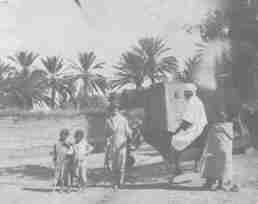A Voyage to Algeria in 1921: Intro
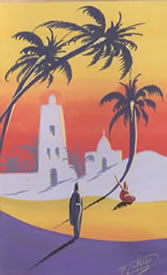
A Voyage to Algeria in 1921: Intro
By: Ella Kolff-van der Giessen (CBCD – XVIv) (1894-1983)
The text follows the original, from her journal; it has been translated by Ella’s grandson Marius (webmaster). All photographs and other images, such as the postcards at this page, are from the journal. Not all of the photographs from the journal could be placed here. The quality, after 80 years, was not always as good as we would have wanted!
Sometimes it was better to leave a Dutch word in the text: in case not evident, it is indicated by italic text. In other cases a word needed explication. Translations and explications can be found at the bottom of that page.
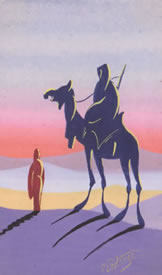
A Voyage to Algeria in 1921: 1 - Paris
Rotterdam 31 January 1921
The whole day is used for the final preparations for the journey. Herman and Jantje will go to Oma Kolff with Ninna, they will stay there. We dine with Father and will spend the night there to be able to go to the train early in the morning.
1 February 1921
At nine o’clock in the morning we board the car and our luggage is being loaded in; however after we are properly seated it seems that the car needs some heavy repairs before it will move. Agitation, phonecalls. Finally, at 9h25 a second car drives up and we and our luggage are transferred and with flying speed we are driven to the D.P. station. Here Moes, with a box filled with delicious hopjes, is awaiting us accompanied by the children and Ninna.
The train departs 9h42 and Herman is calling “safe journey” while we start to move. We take our reserved window seats. At Roosendaal some sjappies check our larger baggage only. At Esschen, we are all – including our smaller and bigger baggage – being filtered through a narrow passage, where they also check our passports. Between Antwerp and Brussels we have lunch in the dining car.
At 8h40 in the evening we arrive at Paris, dusty and tired. After an hour of waiting for our larger luggage we have ourselves brought to the Hotel Continental Rue Rivoli. We have quite an appetite and walk into Paris to drop in the Café de Madrid to feast ourselves on Potage Petite Marmite and a tasty chicken.
Deux Couverts?
Non, merci monsieur, à la carte!
Alors seulement pour madame?
Photo’s at this page are not of Paris, but were found on these pages in the original Journal
Paris 2 February 1921
We start to run and fly through the running and flying Paris. Place Vendôme, Rue de la Paix, Boulevard des Capucines, – des Italiens, – Montmartre. Our cup of coffee we take at the gezellige Café de la Paix, and after this we go to les Magazins de la Fayette. Lunch at the café Pocardi. Having brought our shoppings at the hotel we walk through the Jardin des Tuileries to the Seine. Then we wonder around Les Halles and we take a trolleybus along la Bourse to our familiar area at the Place de l’Opéra. We have dinner at Duval, and go to Les Folies Bergères after that, here we see “l’Amour en Folie” and “La plus belle femme de France” Agnès Souret.

3 February
We continue our shopping at les Magazins du Louvre. A delicious lunch was taken at the restaurant ‘Ciro’.
We bring our shoppings back to the hotel and go to the Eiffel Tower. The weather is dark and foggy so we only go to the first floor and trip the hundreds of steps of the staircase down to the ground floor. In vain we look for Helvetia’s in the empty river the Seine. A car takes us further through the Bois de Boulogne and along the Arc de Triomphe, where just at that moment the head of state of Poland, Marshal Pilsudski, is bringing a flower tribute at the grave of the unknown soldier.
We visit La Fayette and the Louvre. Our dinner we have at the charming restaurant Rizzi, Avenue de l’Opéra.
Paris 4 February Marseilles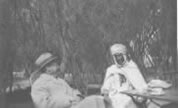
Departure at seven o’clock in the morning from our hotel to “Le Gare de Lyon” from where our train leaves at 8 o’clock. We find our reserved seats and in our compartment are some French travellers and an English lady with her lady-help. Six series of luncheons and dinners are being served in the dining car so we spend almost the entire journey eating. Lunch was between Mâcon and Lyon, and dinner somewhere near Avignon and Tarascon. We arrive 9h40 at Marseilles. We stay at the Grand Hotel du Louvre et de la Paix, a fine room with bath.
A Voyage to Algeria in 1921: 2 - Algiers
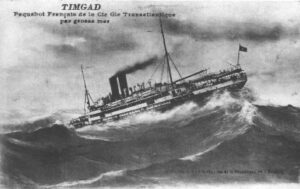
Timgad in a storm
5 February
 10 o’clock: we are brought by bus to the ‘Timgad’. It is stormy weather and poors rain. We have lunch on board of the ship. It leaves after that at twelve o’clock. We enjoy the departure with a amazing view on Marseilles. Quite soon the ship starts to swing to and fro and it is not possible to stay on deck any longer after four o’clock; also because of the extreme cold. AtmosphereWe have an excellent and spacious cabin and regardless the very rough weather we have a good night rest. One of the very few people that went to dine is Jan.
10 o’clock: we are brought by bus to the ‘Timgad’. It is stormy weather and poors rain. We have lunch on board of the ship. It leaves after that at twelve o’clock. We enjoy the departure with a amazing view on Marseilles. Quite soon the ship starts to swing to and fro and it is not possible to stay on deck any longer after four o’clock; also because of the extreme cold. AtmosphereWe have an excellent and spacious cabin and regardless the very rough weather we have a good night rest. One of the very few people that went to dine is Jan.
6 February
The wind does not calm down this day and the ship takes a lot of water. At seven in the evening the lights of Algiers show up and the swinging of the ship ends. The passengers are all on deck standing close together are are swarmed by Arab boys that want to carry their luggage. A boy of around 20 years old takes both our portmanteaus, hatboxes, and the cabin trunk on his back as if this all was not weighing 70 kgs. in total. A bus takes us to the beautiful hotel St. George. In our room we have supper that contains of crispy rolls and chocolate.
 Algiers 7 February
Algiers 7 February
At six in the morning we see the sun rise from our room. Below we can see Algiers, the sea and the pal gardens beautifully lit by the sun. This day we walk in the fine garden and the surroundings of the hotel. In town we take coffee ar the “Café d’Alger”, Place de la Republique. In the evening we go to le Nouveau Theatre where we see an impassioned Arab audience enjoying a very primitive Moorish party.
8 February
We enjoy the sun in our room and at the terrace. It is carnival and we notice that all shops are closed. After 4 o’clock the sun disappears and so does the heat of the entire day.
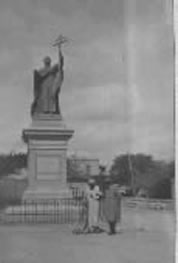 9 february
9 february
Still sunny and warm. At 3 o’clock we wonder about the city and walk into the Cathédral.
10 February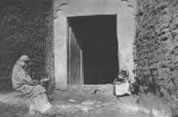
Sunny room and terrace. Walk to hotel Continental where we part in the ’thé dansant’, but where we also see that Louis Couperus has just left Algiers.
11 February
Thanks to our regular sun bath we start to get sun burnt somewhat. In the afternoon we go to the Kasbah and walk there along the Boulevard Gambetta (stairs with very badly placed stone steps), Rue de la Kasba, Mosque Medensa ed Kalibia, Rue du Regand, Rue Bleue, Cathédral.
12 February
Cold on the terrace. Not much sunshine. In the afternoon we have a beautiful walk through the Bois de Boulogne to Birmandreïs. Dazzling is the Ravin de la Femme Sauvage (named after a woman who was selling, secretly, absinth; around 1840), along the Jardin d’Essay. By tram we return through the city back to our hotel.

Kasbah
13 February
It stays cold and it is somewhat windy. Again we have a beautiful walk. We take off at Colonne Voirol along the Chateau Hydra (famous for its great wine), the Merzaug estate, to the village of El Biar. Fantastic panoramas, beautiful plants, many cactussus. And in the end we see Algiers deep down before us. We descend along the Chemin Lapentier – fourteen corners – to the Hotel Continental and continue to our hotel (promenade of 3 1/2 hours).
14 February
The warmth has come back, and how!, temperature doubled. We enjoy the sunshine. In the afternoon a short stroll to the city where we have tea. In the evening a ‘bal costumé’ in the hotel.
15 February
We enjoy the sunshine and stroll through Algiers.
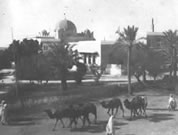
view at mosque.
Other images (at right): atmosphere.
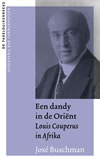 Louis Couperus – renown Dutch writer; Jan’s (Johannes Marius) sister was at the time of Jan and Ella’s voyage to Algeria married to a son (Benjamin Vlielander Hein) of Couperus’ sister: see Genealogy: CBCD. More close family links exist, such as that of Jan and Ella’s son, Jan, who married a daughter of the couple Van Schalkwijk-Vlielander Hein.
Louis Couperus – renown Dutch writer; Jan’s (Johannes Marius) sister was at the time of Jan and Ella’s voyage to Algeria married to a son (Benjamin Vlielander Hein) of Couperus’ sister: see Genealogy: CBCD. More close family links exist, such as that of Jan and Ella’s son, Jan, who married a daughter of the couple Van Schalkwijk-Vlielander Hein.
To more on Couperus and his Vlielander Hein connection (Dutch webiste).
Ella’s journal has been used as part of ‘Een Dandy in de Oriënt, Louis Couperus in Afrika‘ (image at left), as well as several other journals; José Buschman, the writer, investigated the trip of Louis Couperus to Algeria using biographies of others to illustrate Louis Couperus’ trip to Algeria. ‘Een Dandy in de Oriënt‘ (A Dandy in the Orient), by José Buschman, first appeared on April 4, 2009.
A Voyage to Algeria in 1921: 3 - To Biskra
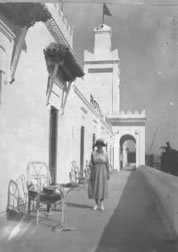 16 February
16 February
Packing the luggage. The sun is hiding herself somewhat again. Both of us go the the hairdresser at the hotel. Some rain, even, drops that are dry by the time they get to the ground. In the hall we have tea and write some letters. We have to dine early because the train will leave at 8 p.m. At seven we get into the bus. We find our reserved places in the sleeper car. Soon after we notice that there seems to be an empty compartment for four persons and with a small tip we manage to get our berths prepared in that compartment. We have a good nights rest and arrive at nine p.m. at El Guerrah (this includes 1 1/2 hours delay).
17 February
A small train with one dining car and two waggons awaits us here. Now our beautiful journey through the desert starts. Very soon we see some large lakes, shallow and still, in which the surrounding mountains are reflected beautifully. Kind of pinkish grey stone mountain tops of which one is covered with snow. Then again stretched out pink coloured plains of sand and stones. Large heards of sheep and black goats with their shepherds dressed in rags. At times a small caravan can be seen trekking the long and sunny road. We pass Batina and come again in the stretched out plain which is dryer and dryer. Then suddenly a wild stream of water, we rush through a gate in the rocks, and El Kantara lies before us. Beautifully stretched out palm forests and many little waterfalls. After many stops we arrive at one thirty in Biskra where we are received by dust-clouds and a lot of wind. A bus takes us to our nice white hotel Royal with its high white tower.
A Voyage to Algeria in 1921: 4 - Garden of Allah
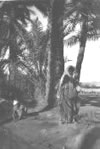
The palmbush
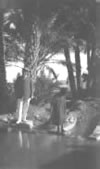
Jan, in
palmbush
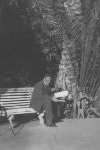
Jan reading
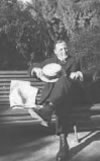
Jan seated in Garden of Allah
18 February
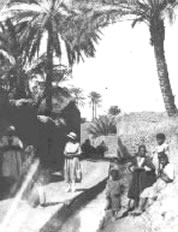
Biskra: We stroll the busy and narrow streets of the village and its Arab inhabitants, stroll the market-place and the street of the Ouled Naïls. In the afternoon to Beni Mora, a deserted and decayed garden. Going back we enter an enclosed little bush of palmtrees where we suddenly see little clay houses, inhabited by negroes, and we have to go back the same way. In the evening we visit the Casino “Grande Tête Arabe”, where a similar primitive show is performed, dancing on tamtam and flute.
19 February
The strong wind persists. The afternoon we spend at the Garden of Allah (Jardin London). A wonderful place to stay where is is cool and it has beautiful little palmtree lined lanes. In these silent surroundings Arbi plays his everlasting tune on the flute. From the dense green vegitation one has a stunning view towards the desert and the mountains in the distance. In the small garden of the Kursaal in the village we take tea. In the evening the guide takes us to a Nomad wedding. Veiled women are illuminated by a beautiful clear Moon and somewhat further away are the men in their burnous. The tamtam plays and the women dance taking turns with slow, weird movements.
20 February
Our morning walk leads us to Vieux Biskra, which exists of seven different groups of houses constructed of earth and loam. The ruins of the old Turkish fortress are in the desert: not much remains of them. We get there through the hamlet of Bab Darb and in the distance we see Medjeniche. We have tea in the village and there we buy the small shoes for the children.
21 February
We spend the afternoon in the Garden of Allah where the “Sand diviner” predicts us our good fortune. Going back we stroll again into the village of the negroes, where all races of the Sudan negroes are represented. We have tea under the palm trees in the garden of the hotel. In the evening we watch the beautiful rising of the moon – together with Mrs. & Mr. Kingham and Mr. & Mrs. Robinson on the roof of the hotel.
22 February
The weather is great: sunny and warm. The battle between Sirocco and North Eastern mountainwind seems to have been fought out. We spend some time on the terrace and stroll the village, chased by Merabti Ali ben Mohamed, our guide. He helps us, in the end, with the necessary purchases for the horseback riding, and he offers us a true Arab cup of coffee in his café.


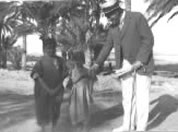 Images (right):
Images (right):
Jan with children;
Arab children;
Jan at ruins Turkish fortress;
Arab children.
Images (top right):
Ella at ruins Turkish fortress;
more children
A Voyage to Algeria in 1921: 5 - Sidi Okba
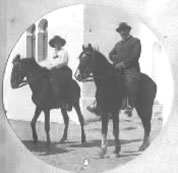


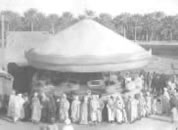
23 February
At nine o’clock we ride out on horseback accompanied by our guide. What follows is a pleasant ride through the desert towards Fontaine Chaude, a hot salpetre source, where one can bathe. Ella and Jan on horsebackOn the way back we gallop a few times while we have a splendid view on the mountains. The afternoon is cold and we take our tea in the hall of the hotel. (24 February does not appear in the journal [ed.].)
25 February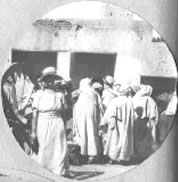
We make a fine excursion in a carriage to Sidi Okba, which is about 20 kms. from Biskra. We have a couple of heavy, strong horses to pull us over the bad, rough road. First we go through the large dry lake which is covered with fine round worn off stones. After, we follow a long straight road right through the desert. Often we are held up due to large caravans because it is very difficult for the Arabs to move the slow and stately walking animals off the road. Magnificent are the pink tinctures of the Aures Mountains that we see in the background.
Sidi Okba is entirely built of sand and clay except for the mosque built of white plastered stone. This mosque is the grand religious centre of the Ziban, an Arab tribe. We brought our lunch along and take it in the garden of Kaïd and then we walk to the mosque. From the distance we can already hear the Marabout’s calling from the tower to bring everybody together for the big mutual prayer. We stayed at the edge of the great open courtyard and saw how the Arabs, all barefoot, facing East, enacted their praying, coupled with a lot of bowing and kneeling and standing up again.
We also climbed the minaret and enjoyed the view on this peculiar place and its surroundings. Walking through the village gave us a nice impression of how the Western civilization did not yet penetrate as far as this area. Our way back was again most interesting and at six thirty we were back to enjoy our tea in the hall.
26 Februari
Again it is wonderful weather, sunny, and we try to enjoy this as much as possible on the terrace and in the afternoon in the “Garden of Allah” sitting on an earthen bench with a splendid view towards the desert.
Images, include: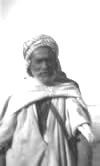
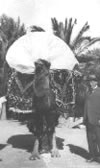
Man in the desert
Jan and Ella on horseback
Ella at camel driver
Ella (presumably) on the market
Fair!
Camel with freight
On the road…
A Voyage to Algeria in 1921: 6 - On horseback again

27 February
Our second ride on horseback leads us through the sand dunes 7 kms. from Biskra. Again we enjoy the spectacular views and the beautiful colours of the sand of the dunes on the rocky soil.Ella and guide on horseback On the way back we dismount and have true Arab coffee in a small café.
28 February
We walk to Vieux Biskra. Would have loved to see the manufacturing of carpets but yet again this is an Arab holiday (beginning of spring). At Bab Darb Jan plays hockey with some Arab boys and we are persuid by a continious humming of “donnez moi un sou, monsieur”.
In the afternoon the guide lures us to the market.
1 March
An open carriage awaits us to take us to Shetma (7 kms.), again a true Arab place. On the driving-box are seated the guide and the waggoner both in the nice Arab way of dressing. Houses at Shetma are higher and at places they form a gate when they are built over the street, which gives the village with its hilly streets a fantastic appearance. A fine cup of coffee we got at an Arab café where several Arabs were sleeping on mats. For the farewell to the guide we had, at coming home, coffee at the “Kursaal”.

Images at right
from top to bottom:
Ella with young drommedary
village view
evening talk
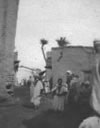 Image above: Ella, amazone on horseback with the guide Merabti Ali ben Mohamed
Image above: Ella, amazone on horseback with the guide Merabti Ali ben Mohamed
Here, left:
view on the village, and
two ‘beauties’
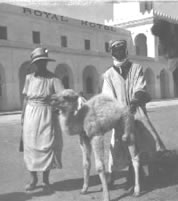


Apparently the photograph of Ella as amazone was taken with too much light, and is – on placing it at this site – also more than 80 years old!
Yet I placed it because I liked the combination of Ella with the guide, and Ella sitting very elegant on the horse as amazone. Aspecially I liked the description of the little gallops through the desert, and that as an amazone… [Marius])
A Voyage to Algeria in 1921: 7 - Back in Algiers

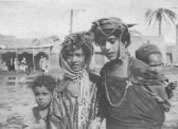
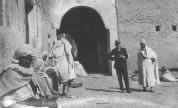

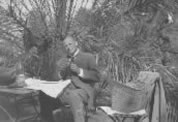
2 March
We pack our suitcases and take some time to enjoy our last sunbeams in the desert. For our farewell the guide brings us a nice bouquet of flowers and all ask us for just one more cup of coffee – to our health – before we go. Our return journey starts at 2h58 and from our window seats we have the opportunity to enjoy our last beautiful panoramas that the desert offered us. Again we see the deep pink tinctures of the mountains while the sun sets, as we have seen this so often from the roof of the hotel. Again, also, is the passing of the ‘Gate of the Desert’ El Kantara. At El Guerrah we take the night train and we sleep very well until Palastro. It feels good, after all the drought and barren-ness of the surroundings of Biskra, to see the abundantly lush green mountains and valleys, with at times – hidden in the green – villages, and rather soon the sea in the background.
Images:
Ella amidst the men at Biskra;
Nice youngsters – Gate – with Jan, Jan amidst children;
Jan resting with newspaper.
at right above here: Ella having the farewell cup of coffee
ar right here: business card of guide Merabti Ali Ben Mohamed
at right below, first: a page from the diary,
next to that: Een Dandy in de Oriënt, by José Buschman.
3 March
Eight thirty the train arrives at Algiers and soon we see before us the familiar Hotel St. George where again we get a very good room.
This is where the journal ends;
on more days at Algiers and the return voyage to Rotterdam nothing is mentioned.
The diary on her voyage to Algeria in 1921 of Ella Kolff-van der Giessen (CBCD XVIv) has been used in the publication ‘Een dandy in de Oriënt, Louis Couperus in Afrika
 (A dandy in the Orient, Louis Couperus in Africa), by José Buschman
(A dandy in the Orient, Louis Couperus in Africa), by José Buschman
(first appeared April, 2009, more about this in News)..
